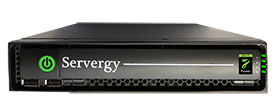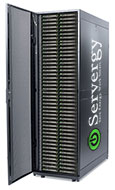“A yearlong examination by The New York Times has revealed that this foundation of the information industry is sharply at odds with its image of sleek efficiency and environmental friendliness,” writes author James Glanz in this first part of a series planned by the publication, and he goes on to paint a dark picture, indeed.
 For example: “Most data centers, by design, consume vast amounts of energy in an incongruously wasteful manner, interviews and documents show,” he writes.
For example: “Most data centers, by design, consume vast amounts of energy in an incongruously wasteful manner, interviews and documents show,” he writes.
“Data centers can waste 90 percent or more of the electricity they pull off the grid,” he adds.
The list of charges leads Glanz to conclude that “the inefficient use of power is largely driven by a symbiotic relationship between users who demand an instantaneous response to the click of a mouse and companies that put their business at risk if they fail to meet that expectation.”
An Outdated Picture?
Now, it would be difficult to dispute the validity of Glanz’s research — particularly when it comes to data centers still using traditional server technologies.
Nevertheless, his article has been met with considerable outcry, not least from the tech industry itself via Wired, InformationWeek and beyond. First and foremost among critics’ rebuttals is that the Times article focuses primarily on older data center technologies, largely ignoring all the many advances in efficiency that are being made today.
With that in mind, Linux.com spoke earlier this week with Bill Mapp, CEO, chairman and founder of Servergy, along with William Mapp IV, the company’s vice president of strategic projects. As a member of the Linux Foundation and a maker of hyperefficient, high-performance Power Linux servers, Servergy is on the forefront of some of the efficiency gains now coming to the modern data center.
‘The Huge Need Out There’
 “This is a major reason why Servergy was born,” vice president Mapp told Linux.com. “As the whole world goes online, that’s a lot of apps downloaded, Netflix movies streamed and Dropbox files exchanged. All that has to be stored someplace, and it has to be done in a more efficient manner.”
“This is a major reason why Servergy was born,” vice president Mapp told Linux.com. “As the whole world goes online, that’s a lot of apps downloaded, Netflix movies streamed and Dropbox files exchanged. All that has to be stored someplace, and it has to be done in a more efficient manner.”
ARM, of course, is one architecture increasingly being embraced for server use by companies including Dell for its power efficiency, among other features, but Servergy chose to build its own platform on the mature Power architecture instead.
Compared with traditional data center servers, Servergy’s compact Power Linux systems boast savings of 80 percent or more in both server power costs and space requirements, the company says.
“This is only going to get more important as we move forward,” CEO Mapp pointed out. “That giant sucking sound you hear is the huge need out there for lower power.”
‘No Single Technology’
Indeed, earlier this month Pike Research, a part of Navigant’s Energy Practice, released some data affirming just that. Specifically, it predicts that the worldwide market for green data centers will grow from $17.1 billion in 2012 to $45.4 billion by 2016, representing a compound annual growth rate of nearly 28 percent.
Virtualization and cloud computing are two of the biggest trends behind those improving efficiencies, it adds.
“There is no single technology or design model that makes a data center green,” noted Pike research director Eric Woods. “In fact, the green data center is connected to the broader transformation that data centers are undergoing – a transformation that encompasses technical innovation, operational improvements, new design principles, changes to the relationship between IT and business, and changes in the data center supply chain.”
‘An Accelerator for Linux’
Servergy, meanwhile, is a big proponent of the many benefits of using Linux, including not just efficiency but also security.
“It provides an ecosystem in which people can come together — both hardware vendors like us and the open source community with software — to come up with efficient solutions,” vice president Mapp asserted.
“It’s not just a trend, it’s the future — it’s where the data center is going,” he concluded. “This area is going to be an accelerator for Linux.”


